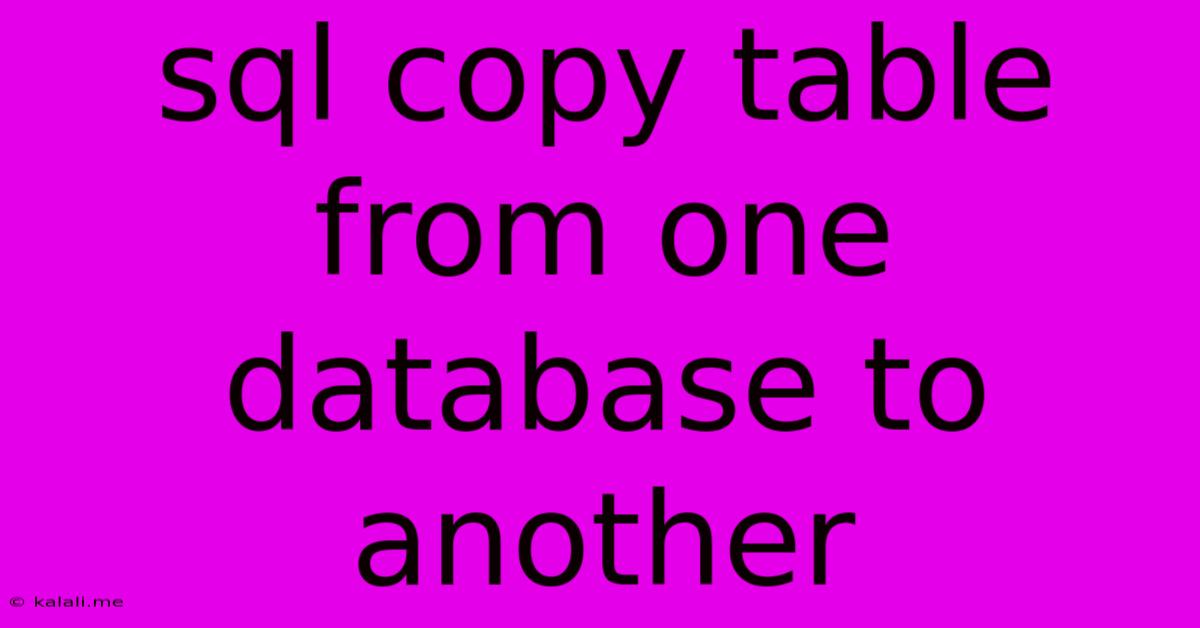Sql Copy Table From One Database To Another
Kalali
Jun 03, 2025 · 3 min read

Table of Contents
Copying SQL Tables Between Databases: A Comprehensive Guide
Copying an entire SQL table from one database to another is a common task in database administration and development. This process, often required for backups, data migration, or creating development/testing environments, can be achieved through several methods, each with its own advantages and disadvantages. This guide provides a comprehensive overview of these methods, focusing on efficiency and best practices. Understanding the nuances of each method will enable you to choose the optimal approach for your specific needs.
Understanding the Context: Why Copy SQL Tables?
Before diving into the methods, let's clarify the common scenarios where you might need to copy a SQL table:
- Database backups: Creating a complete or incremental backup of your data is crucial for disaster recovery.
- Data migration: Moving data from one database system (e.g., MySQL to PostgreSQL) or from an older version to a newer one.
- Development/testing: Creating a replica of your production database for testing purposes without affecting the live environment.
- Data warehousing: Extracting data from operational databases into a data warehouse for analysis.
- Data replication: Creating a synchronized copy of a table across multiple databases for high availability or improved performance.
Methods for Copying SQL Tables
Several techniques can be employed to copy SQL tables between databases. The best choice depends on factors like database systems involved, data volume, and the desired level of data consistency.
1. Using INSERT INTO ... SELECT Statement
This is a straightforward approach suitable for smaller tables and situations where data consistency isn't paramount. This method selects data from the source table and inserts it into the destination table.
INSERT INTO database2.schema2.target_table (column1, column2, column3)
SELECT column1, column2, column3
FROM database1.schema1.source_table;
Advantages: Simple and easy to understand.
Disadvantages: Can be slow for large tables. Doesn't handle constraints or triggers effectively. Requires the destination table to exist beforehand with the correct schema.
2. Using CREATE TABLE ... AS SELECT Statement
Similar to the INSERT INTO ... SELECT method, this approach creates a new table in the destination database directly from the query results.
CREATE TABLE database2.schema2.target_table AS
SELECT column1, column2, column3
FROM database1.schema1.source_table;
Advantages: Creates the table and populates it simultaneously. Slightly more efficient than the INSERT INTO method for larger datasets.
Disadvantages: Still potentially slow for very large tables. Doesn't handle complex constraints or triggers gracefully.
3. Using Database-Specific Utilities
Most database systems (e.g., MySQL, PostgreSQL, SQL Server) offer their own utilities for database and table backups and restores. These utilities often provide options for exporting data to a file and then importing it into another database.
Advantages: Usually very efficient, especially for large datasets. Handles various data types and constraints effectively. Often part of the database management system.
Disadvantages: Requires familiarity with the specific utility and its command-line options or GUI.
4. Using ETL Tools
For large-scale data migration projects, using an Extract, Transform, Load (ETL) tool is often the most efficient and reliable approach. ETL tools offer sophisticated features for data transformation, error handling, and scheduling.
Advantages: Handles extremely large datasets efficiently. Offers advanced data transformation capabilities. Provides features for data validation and error handling.
Disadvantages: Requires learning the ETL tool and its interface. Can be a complex and expensive solution for smaller projects.
Best Practices for Copying SQL Tables
- Backup your data: Always back up your source database before performing any data migration tasks.
- Test thoroughly: Test your copying process on a small subset of the data before applying it to the entire table.
- Handle constraints and triggers: Ensure your target table has the appropriate constraints and triggers.
- Monitor performance: For large tables, monitor the copying process to identify and address any performance bottlenecks.
- Consider data consistency: Choose a method that ensures data consistency, especially if the source table is actively being updated.
- Use appropriate tools: Select the right tools for your specific needs and the size of your data.
By carefully considering these methods and best practices, you can effectively copy SQL tables between databases while ensuring data integrity and efficiency. Remember to always choose the approach that best suits your specific requirements and available resources.
Latest Posts
Latest Posts
-
Light Switch Wiring Diagram Multiple Lights
Jun 05, 2025
-
My Hp Monitor Wont Adjust Resolution Mac
Jun 05, 2025
-
Vscode Terminal Sendsequence Zsh Delete Cursor Left
Jun 05, 2025
-
Is There A Way To Order Whatsapp Statusold To New
Jun 05, 2025
-
Download Icloud Photos To External Storage
Jun 05, 2025
Related Post
Thank you for visiting our website which covers about Sql Copy Table From One Database To Another . We hope the information provided has been useful to you. Feel free to contact us if you have any questions or need further assistance. See you next time and don't miss to bookmark.